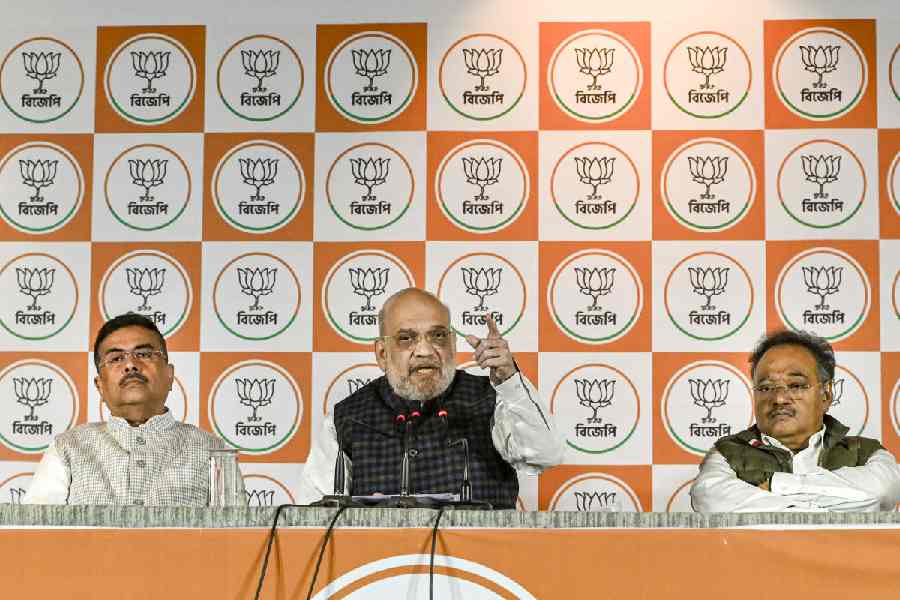The Narendra Modi government appears to have taken its first stab at austerity after the Covid crisis blew a hole through its finances and ran into problems in funding a Rs 20.97-lakh-crore “stimulus” package unveiled last month amid fanfare.
A cryptic circular sent out by the department of expenditure within the Union finance ministry has directed the various ministries to suspend all new schemes with funding commitments of up to Rs 500 crore till March next year.
The circular said these schemes had earlier received in-principle approval this financial year.
In an official release issued dated June 4, the government said that only schemes announced under the Atmanirbhar Bharat Abhiyan and the Pradhan Mantri Garib Kalyan packages would be initiated and continued in the current financial year.
In an office memorandum sent out on Wednesday, the expenditure department said: “In the wake of Covid-19 pandemic, there is unprecedented demand on the public financial resources and a need to use resources prudently in accordance with emerging and changing priorities.”
The office memorandum stated: “The initiation of new schemes already apprised/approved in Financial Year 2020-21 under delegated powers of the administrative ministries, including SFC (Standing Finance Committee) proposals, (schemes up to Rs 500 crore) will remain suspended for one year till March 31, 2021, or till further orders, whichever is earlier.”
The order exempts the Covid-related schemes.
“No new proposal for a scheme/sub-scheme, whether under delegated powers to administrative ministry should be initiated this year (FY 2020-21), except the proposals announced under Pradhan Mantri Garib Kalyan Yojana or Atma Nirbhar Bharat Abhiyan package and any other special package/announcement,” the circular said.
Questions galore
The latest circular raises a lot of questions. To start with, there are virtually no new schemes for which funds were provided for the first time in the expenditure budget document that forms part of this year’s budget papers.
The stimulus package had been roundly criticised for not doing enough and for trying to pass off spending that had already been committed in the budget finance minister Nirmala Sitharaman presented on February 1 as fresh government expenditure – when it was clearly not so.
Now, the financial jiggery-pokery stands exposed.
The terse note is actually asking ministries to focus expenditure on the two main components of the stimulus measures: the Rs 11.02-lakh-crore, five-tranche Atmanirbhar Bharat Abhiyan blitz of announcements between May 13 and 17, and the Rs 1.7-lakh-crore package that was unveiled on March 26, two days after Prime Minister Modi imposed the hard lockdown on the nation.
The shortfall was made up by taking into account the impact of the Reserve Bank of India’s monetary measures assessed at Rs 8.01 lakh crore.
There has always been a suspicion that the Centre -– already battling a surge in its fiscal deficit last year -– would not commit any new funds and would resort to accounting jugglery. The ministries will most likely shovel funds meant for other schemes into these two “stimulus” programmes of the government this year.
Finance ministry officials did not share the amount of savings that would result from the latest diktat. Nor did it say which central schemes would bear the brunt of the axe.
Officials said this is not an expenditure cut but a strategy to focus on the Rs 20 lakh crore Pradhan Mantri Garib Kalyan Yojana and the Atma Nirbhar Bharat Abhiyan package.
The “austerity” measures come just a few days after Moody’s Investor Services downgraded India’s foreign currency and local currency long-term issuer ratings from Baa2 to Baa3 -– the lowest rung in its investment grade rating scale.
One of the reasons that US-based global credit rating agency had cited for its action was “significant deterioration in the general government fiscal position”.
Revenue shortfall
N.R. Bhanumurthy, professor at the National Institute of Public finance and Policy, said this is a clear indication that a shortfall in revenue has forced the government to re-prioritise its spending. The government’s focus should be to step up spending in sectors that provide large employment.
“Construction is one activity that provides large-scale employment. And so do the micro, small and medium enterprises…. The government should look to readjust expenditure without compromising spending in important sectors. If there is a decline in the overall government expenditure, it will be counter-productive to growth,” he said.
Several economists and analysts have predicted that the Indian economy will contract this fiscal by as much as 5 per cent.
In early April, finance ministry imposed spending caps on some ministries and departments, ranging between 15 and 20 per cent of the budgeted level in the April-June quarter of the current financial year.
The central government had also announced a freeze on increments of DA and dearness relief to government employees and pensioners.
In the first quarter of the fiscal, the government usually spends 30 per cent of the budgeted expenditure.
“At a 30 per cent run-rate, the expenditure in the first quarter would be Rs 9.25 lakh crore. If category B and C ministries and departments were to limit their expenditures to 20 per cent and 15 per cent respectively, total expenditure in the first quarter would be Rs 7.35 lakh crore. This should lead to potential savings of Rs 1.90 lakh crore. This, however, is unlikely to happen …. (as they are) mandatory type: establishment, finance commission mandated transfers etc. In all likelihood, this expenditure will take place at the normal pace,” former finance secretary Subhash Chandra Garghad written in his blog.
The finance ministry was forced to resort to such drastic measures after the government’s revenue receipts hit an all-time low.
Data available from the Controller General of Accounts (CGA) shows that total revenue receipts during April 2020 was a paltry Rs 27,548 crore which amounts to 1.2 per cent of the Budget Estimate. In comparison, the total expenditure incurred by the government was a whopping Rs 3.07 lakh crore, which is 10 per cent of the budget estimate.
In early May, to tide over the financial crunch, the government has announced that it would be increasing its market borrowing estimate by Rs 4.2 lakh crore to Rs 12 lakh crore for the current fiscal.
The CGA data reveals that in the first month of the fiscal year, more than one third of the estimated fiscal deficit has already been exhausted.
Ongoing schemes
The Centre has clarified that schemes that fall in the “ongoing category” will be implemented in line with an order issued in January which prescribes an interim extension till March 31, 2020, or till the date of recommendations of 15th Finance Commission comes into effect (whichever is earlier).
This rule would be apply to all the schemes where there is no change in the scope, nature, coverage and without any additional cost. But, according to the order, the continuation of all such schemes would be based on an outcome review.
The order says continuing schemes will require fresh appraisal and approval for the period of 2021-22 to 2025-26. In any case, the fate of these schemes will be decided after the acceptance of the recommendations of the 15th Finance Commission and the position regarding resources in the public exchequer becomes clear.
The austerity move comes at a time when revenues are expected to contract by more than Rs 4 lakh crore in 2020-21.
The disinvestment target of Rs 2.1 lakh crore is also unlikely to be achieved, exerting pressure on the country’s fiscal deficit.
The government has already announced a 50 per cent increase in its market borrowings this year – it will borrow an additional Rs 4.2 lakh crore in 2020-21, taking the total borrowings to Rs 12 lakh crore as against the initially budgeted Rs 7.8 lakh crore.
The higher borrowing could also lead to a surge in interest payments.
The budget had provided for interest payment of Rs 7.08 lakh crore this year, which was more than 13 per cent higher than the revised estimate of Rs 6.25 lakh crore in 2019-20.
Interest payments amount to over 23 per cent of the overall expenditure of Rs 30.4 lakh crore in this year’s budget.










